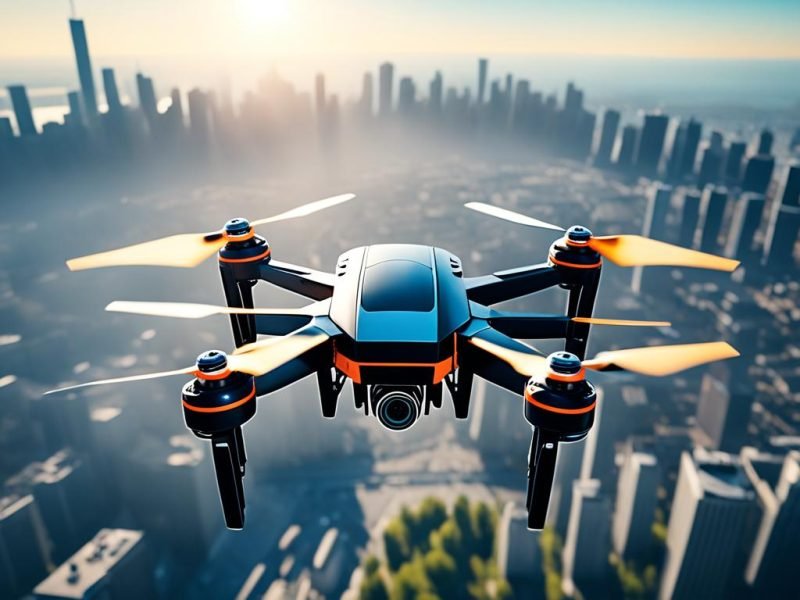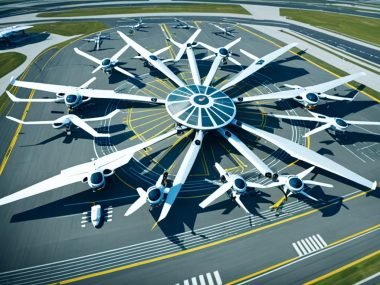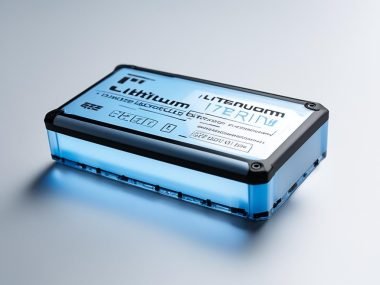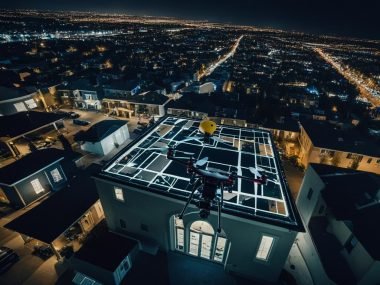Today, our dreams soar high with the innovation of large drones. We constantly ask, “Can Drones Be Big?”. With each breakthrough, large drones prove they aren’t just a glimpse into the future. They are a present reality. They go beyond the simple joys of flying for fun or taking photos from the sky.
Drones have evolved from delicate tools for photographers to sturdy giants of the sky. They now serve industries, flying high with purpose. These giants can carry heavy loads, making tasks like shooting films and delivering goods from the air possible.
We are at the edge of a new era, looking up with hope. Large drones show us the limitless skies of possibility. They mirror our endless dreams, flying further and doing more than ever before.
Key Takeaways
- The expansion of drone technology signifies a step towards more substantial and resilient aerial vehicles.
- Large drones have successfully adopted a range of applications, from logistics to advanced cinematography.
- Drone capabilities now include carrying hefty payloads that were once the domain of ground transportation.
- The burgeoning curiosity around the size of drones highlights their evolution from simple hobbyist devices to heavy-lift aerial workhorses.
- Technological advancements have made it a reality for drones to be big, unlocking new potentials in aerial applications.
Exploring the Rise of Large Drones
We’re seeing a big rise of large drones in unmanned flight. These machines are changing industries with their advanced drone technology. They’ve moved from just taking great aerial shots to doing complex tasks. This marks a big step in drone capabilities. The demand for these big drones is huge. Their popularity soaring shows they’re now key in many fields beyond just taking pictures.
Increased Popularity and Advanced Capabilities
The draw towards these big drones isn’t just because they’re big. It’s also about their wide use and tech advancements. Where small drones once flew, now we see big ones doing more complex work. They help in large-scale farming and detailed city surveys. This wide range of uses keeps making popular to large drones even more popular.
From Fragile Cameras to Robust Aerial Vehicles
Drone have come a long way from being fragile to now being tough and versatile. Today’s big drones can carry goods and help in logistics and medical deliveries. They fly with heavy loads that would have been too much before. This shows how fast drone technology is moving forward.
Now, we’re not just seeing tech advancements. We’re seeing how drones change the game in the air. These big drones show the power of modern engineering. They’re opening new doors for industries worldwide. Their rise shows how people’s interest and their uses are growing together, making a new story in human creativity.
Understanding Heavy Lift Drones and Their Functionality
The field of heavy lift drones is changing how we view transportation and logistics across different sectors. Payload drones, leading the UAV technology, are showing their value in business uses. They also push the limits on drone weight limits and the delivery of heavy loads.
Now, let’s explore how these big drones can lift and move heavier things than before.
The Workings of Heavy Payload Drones
Heavy payload drones are based on advanced design and high-tech UAV technology. They have strong frames, high-power motors, and big propellers to handle heavy weights. These drones need to be tough but nimble to carry goods safely under different weather conditions.
Drone Weight Capacity: A Technological Feat
Drone weight capacity shows how useful and powerful a drone is. While typical consumer drones carry light items, industrial-strength heavy lift drones can transport loads from 20 kg to 220 kg. This amazing achievement is due to thorough design work and ongoing tech improvements, allowing drones to carry items weighing more than half their own weight steadily.
- Transport of goods in challenging or remote environments
- Deployment for industrial and agricultural aerial tasks
- Aerial photography equipment lifting for film and media
The uses mentioned are just starting points for exploring the capabilities of heavy lift drones. As this area grows, we can expect to see even more uses and benefits from drones that can carry large payloads, pushing what’s possible in the skies to new heights.
The Versatility of Drone Sizes and Types
Our ambitions soar as high as the variety of drones in the sky. Different drone sizes and types have unique roles. Multi-rotor drones are known for precision, while VTOL fixed-wing drones go far and wide.
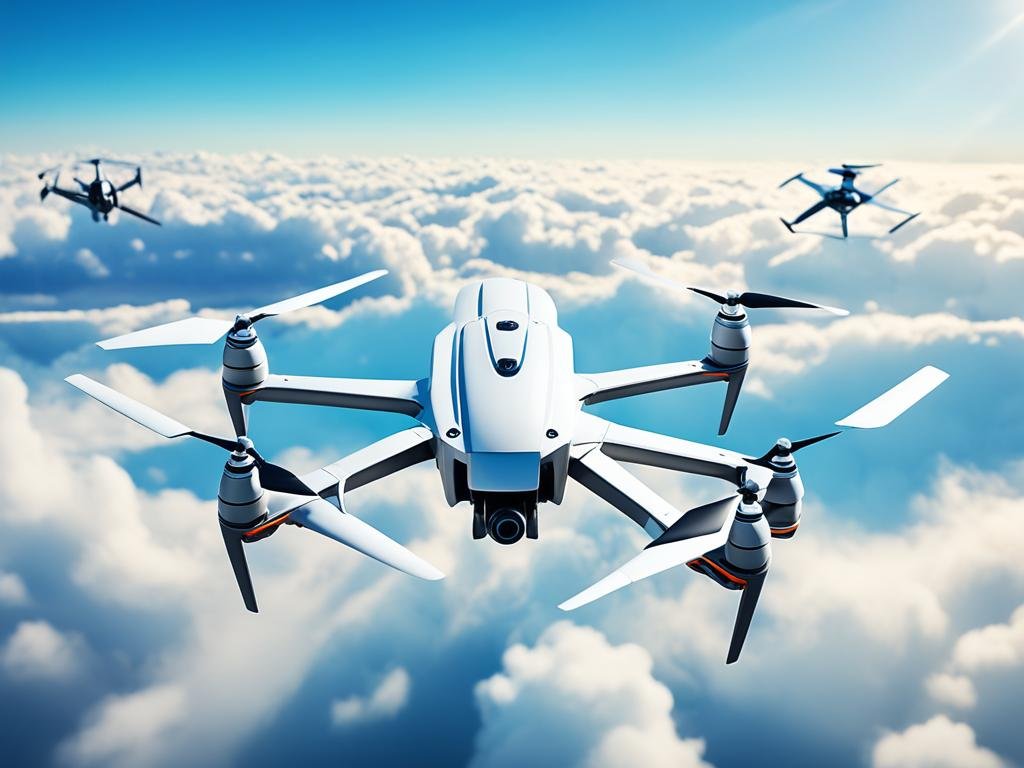
Multi-Rotor Drones: Stability Meets Simplicity
Multi-rotor drones are loved for their balance and easy use. They shine in making movies and showcasing real estate from above. Their balanced propellers allow them to hover and glide smoothly.
Multi-rotor drones, with their horizontal flight paths and vertical takeoffs and landings, revolutionize how we perceive and interact with our world from above.
VTOL Fixed-Wing Drones: Enhanced Endurance
VTOL fixed-wing drones blend aircraft speed with helicopter mobility. They tackle long missions across vast areas with great payload abilities.
Here’s a closer look at these drones:
| Drone Type | Notable Feature | Payload Capacity | Flight Duration |
|---|---|---|---|
| Multi-Rotor Drones | High Stability | Up to 5 kg | 25-30 min |
| VTOL Fixed-Wing Drones | Extended Range | Up to 20 kg | Up to 1 hr or more |
Finally, choosing between a quiet quadcopter and a VTOL fixed-wing drone depends on the task. Each drone type has its strengths for different missions.
The Expanding Role of Drones in Various Industries
Drone technology has changed many industries in big ways. This includes everything from complex inspections by engineering drones to farming improvements with agriculture drones. Cargo delivery drones also play a big part in making sure items arrive on time. These unmanned aircraft systems are making things better and faster across the board.
Engineering, Agriculture, and Cargo Delivery
At building sites, seeing engineering drones is now normal. They get to hard-to-reach spots and gather important data. This helps make sure buildings are safe. In farming, drones do a lot, like checking crops and spraying them very precisely. And cargo drones are changing how we send packages, especially to far-off places. This makes it easier to connect rural areas with big cities.
Drones are becoming more and more essential across different fields. Here’s a table showing how they’re used:
| Industry | Drone Application | Benefit |
|---|---|---|
| Engineering | Inspection and Mapping | Enhanced Accuracy and Safety |
| Agriculture | Crop Monitoring and Spraying | Increased Yield and Reduced Waste |
| Logistics | Package Delivery | Speed and Accessibility |
Disaster Relief Efforts and Military Operations
Drones for disaster relief quickly get through areas hit by disasters. They’re fast and flexible, which is crucial for saving lives and assessing damage. Military drones, besides spying, now also offer support by taking gear to troops in dangerous places. Their help is crucial in risky and complex situations.
The future of drones in our industries looks bright. We’re finding more ways to use drones, like for engineering, agriculture, cargo, disaster relief, and military needs. This new technology is improving how we work and keeping us safe. It’s opening doors to exciting possibilities we once only dreamed of.
Key Components of Heavy Payload Drones
Heavy payload drones excel with their power and ability to do tasks once thought impossible. We dive into the complexities of these powerful machines. Let’s look at the key parts that give them their remarkable power.
Powerful Motors and Efficient Propellers
At the heart of a heavy payload drone are the drone motors. These motors are designed to lift heavy weights with ease. Then, there are the drone propellers, made from strong materials like carbon fiber. They help with better flying and efficiency. Together, these parts help drones reach new heights.
Gimbals: Ensuring Stability for Precision Work
Drone gimbals are crucial for precise tasks such as filming and surveying. They use drone stability technology to stay steady in the air. This is important for getting smooth video shots or detailed maps, even with heavy items attached.
Factors to Consider When Purchasing a Heavy Lift Drone
When looking to purchase a heavy lift drone, there are several key factors to consider. The drone flight time matters because it affects how long your drone can operate without recharging. Also, understanding the drone payload type is crucial for your tasks. Different jobs need different capacities and attachments. And remember, the cost of heavy lift drones varies. Some options might be more expensive than others.

In our detailed drone buying guide, we’ve provided a table. It highlights the essential features to think about before buying your heavy lift drone. This guide is designed to help you make the best choice. It matches your project needs and budget.
| Feature | Details to Consider | Why It’s Important |
|---|---|---|
| Maximum Payload | Assess the weight the drone can carry | Ensures the drone can handle the intended cargo or equipment |
| Battery Life and Flight Time | Check the average time a drone can fly on a single charge | Longer flight times increase operational efficiency |
| Price Range | Evaluate options from economical to high-end models | Helps maintain budget control while fulfilling project specs |
| Compatibility with Payload Types | Verify if the drone supports your specific payload attachments | Enables the utilization of necessary tools and sensors |
| After-Sales Support and Warranty | Examine the extent of customer service and warranty terms | Provides assistance and protection post-purchase |
Choosing the right heavy lift drone might seem tough, but we’re here to help. By doing your research and knowing what you need, you can make a smart buy. This ensures success in various missions like filmmaking, mapping, or inspections. A drone is a big boost to your project’s success. So, it’s important to consider these factors carefully. By doing so, you ensure a wise investment in your tech tools.
The Evolution of Drones: From Quadcopters to Advanced Models
The story of drone development shows human creativity. It’s about how drones have changed over time. They evolved thanks to decades of innovation. Let’s look into how these devices began and changed.
The Pioneering Designs in Drone History
Drones started as simple, remote-controlled machines for the military. This early stage was crucial for modern aviation. It’s linked with the start of quadcopter history. Quadcopters have four rotors. They mix simplicity and effectiveness well.
Dawn of the Quadcopter and its Transformative Impact
The quadcopter changed aerial devices hugely. It made controlling drones in the sky very precise. This change was key in drone designs transformation. Now, drones can navigate using GPS, stream video live, and stabilize themselves. This started a new phase of advanced drone models.
Drones are now in many areas of life. They’re more sophisticated and can do unbelievable tasks. They help in surveying areas and delivering essentials to hard-to-reach places. Drones have become very important tools.
In celebrating drone changes, we made a table. It shows key moments in drone evolution. These milestones helped create today’s advanced models:
| Year | Milestone | Impact on Drone Evolution |
|---|---|---|
| Early 1900s | First unmanned aerial vehicles for military use | Laid the groundwork for drone technology advancement |
| 1930s-1940s | Development of radio-controlled aircraft | Introduced the concept of remote operation |
| 1960s | Usage of drones for surveillance in the Vietnam War | Expanded the practical application of drones into reconnaissance |
| 2000s | Introduction of commercial quadcopters | Quadcopters became mainstream, increasing accessibility for personal use |
| 2010s-Present | Incorporation of AI and machine learning | Drone capabilities expanded into autonomous operations and advanced applications |
Looking at this table, each innovation not only added more uses for drones but also affected many industries. The skies are no longer just for birds and planes. They’re filled with drones, our creations. We’re eager to see how drones will change our future.
“Can Drones Be Big?” Probing the Bounds of Drone Dimensions
Exploring modern aviation, we find the discussion of maximum drone size fascinating. The rise of large drone dimensions has changed aerial dynamics. It shows that drones have potentials beyond their original designs.
We aim to see how big drones can get through a detailed drone size assessment. This exploration highlights their growing role in commercial use and impact on the aviation industry.
Assessing the Maximum Size of Drones in Operation
Drones have grown beyond the small sizes many think of. These large machines are not just changing how we use the sky but also what’s possible. They do tasks once done by manned aircraft, which is a big change for aviation.
Large Drones and Their Influence on Modern Aviation
Large drones show how fast technology is moving. They suggest a future where our skies are filled with smart, task-doing giants. This change is not just about new gadgets; it’s a big shift in how our society might work with drones.
| Drone Model | Dimensions (Length x Width x Height) | Payload Capacity | Application |
|---|---|---|---|
| FreeFly Astro | 1.24m x 1.23m x 0.48m | Up to 10 kg | Filming and Surveying |
| DJI Matrice 300 RTK | 0.81m x 0.43m x 0.43m (Without Propellers) | Up to 2.7 kg | Industrial Inspection |
| GRIFF 135 | 2.15m x 1.8m x 0.95m | Up to 30 kg | Logistics and Cargo Delivery |
These drones are showing us new possibilities and guiding the way for future innovations. As technology grows, maximum drone size might keep reaching new heights. This marks an exciting time in aviation and remote control technology.
Comparative Analysis: A Look at the Best Heavy Lift Drones
We explored the top heavy lift drones to measure their impact in aerial innovation. Our analysis looked at payload capacity, flight behavior, and range. These findings help both enthusiasts and professionals find the best drones for their needs.
From LiDAR Equipped Hexacopters to Massive Octocopters
Drones have evolved remarkably, from advanced LiDAR models to powerful octocopters. The JOUAV PH-20 stands out with its high-tech LiDAR sensors. This tech is crucial for industries that need precise mapping and data.
How Payload and Flight Capabilities Rank Among Top Models
The GRIFF Aviation 300 impresses with its ability to carry up to 227 kg. This shows how drone designs have progressed. We consider payload size vital but also look at flight time and performance. This helps professionals choose the right drone for their work.

